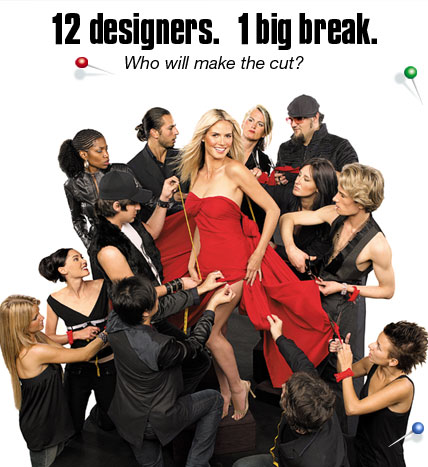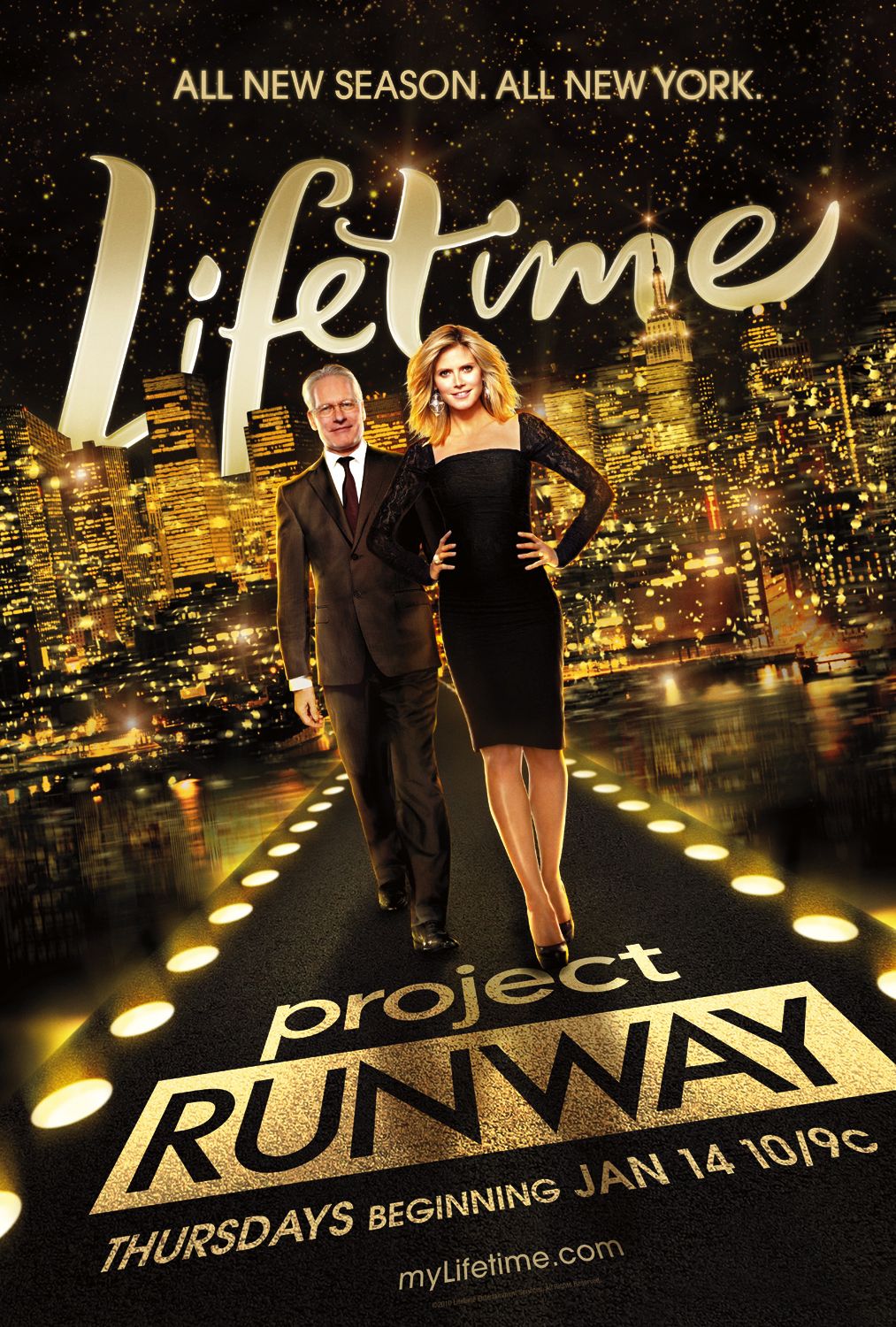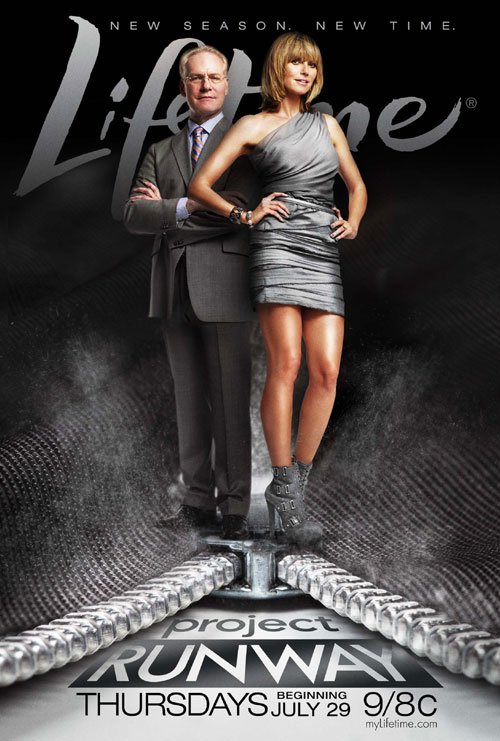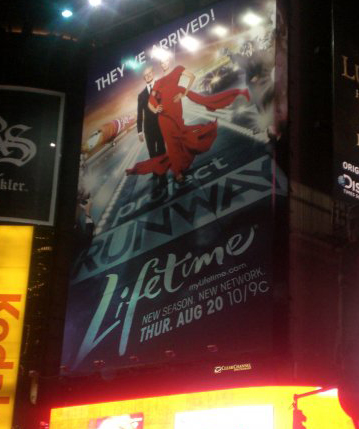Applying a psychoanalytical approach to Project Runway will allow us to uncover the
messages sent to viewers and society about how to see fashion and how it has been applied
to our culture. Gillian Rose defines psychoanalysis as "a range of theories that deal most
centrally with human subjectivity, sexuality and the unconscious" (Rose, p. 149). When
thinking about how psychoanalysis can be applied to this television show many theories
will hold a great deal of importance on contrasting the details of the images being
presented as well as taking the show as a whole and breaking it down by detail. A viewer
is able to look at these images and identity with them on a level of wanting to be and or
look like them. In this section we will look also look at how the models of Project Runway
are viewed in their own show called Models of the Runway.
One of the most common forms of psychoanalysis is scopophilia, "the pleasure of
looking" (Rose, p. 149). Viewers who actively watch the show express scopophilia because
they enjoy what they're seeing while they sit down on their couch once a week to watch the
slightly dramatic reality show that shows designers fighting till the end to get to the
top. These viewers take pleasure in the fact that from a distance they are allowed to
observe what is going on in the reality show and get their own form of pleasure out of it.
Reality television is "programs that film real people as they live out events in their
lives, continued or otherwise, as they occur" (Beck, Hellmueller, Aeschbacher, p. 5), in
this case anywhere from twelve to sixteen designers from around the country come together
to live their lives on the show until they either win or get eliminated from the
competition. Considering Project Runway as a reality show allows the viewers to get
attached to these peoples lives. People on the show open up to viewers by expressing their
good times and their bad, which then allows the viewers to feel as if they now have an
emotional attachment to them. Viewers feel a sense of "connectedness" where they create a
relationship with the characters or in this case the designers and models of the show
(Patino, Kaltcheva, Smith, p. 289).
When watching Project Runway and Models of the Runway, every single character is
subjective in some way. Rose defines subjectivity as a way "that we make sense of
non-rational ways of understanding" (p. 153). By this Roses' meaning is that by subjecting
the characters on both shows the viewers are able to feel things emotionally. This can
lead to viewers asking themselves questions about the show due to their emotional feelings
about a character. Questions could be: why did they get kicked off? Did Heidi really not
like the full outfit? Did that person really not get eliminated? I thought his/her work
was awful. These are just a few examples of how a person could feel during or after the
show. The designers and models also become subjects for the judges. Judges have the
ability to see what the designers have been working on and get to evaluate their work as
the models strut down the runway at the end of the week. In Reality TV: Remaking
Television Culture, Heather Hendershot expresses thoughts on how a show like Project Runway,
or any reality television show, can be subjective in some way. The quote, "to win one must
be evaluated by a judge or boss, in some manner that presents itself as objective or
subjective" (p. 246), meaning that due to the circumstances of the show both designers and
models have to go through an evaluation period where they are put on the spot. They then
get to hear the feelings of either the judges on how they did or in the models case they
hear how the designers felt about working with them and how they thought they did on the
runway. Models and designers also have to undergo the use of gaze. Gaze is defined as "how
the subject is seen" (Rose, p. 172). In this case viewers and judges are gazing upon the
designers and models. Gaze has the ability to go on even when you can see now longer. So
when applying this concept to both Project Runway and Models of the Runway we can ask
ourselves the question of what happens once the show is over? In this case we can assume
viewers apply what they see on the reality television to their own fashion identity.
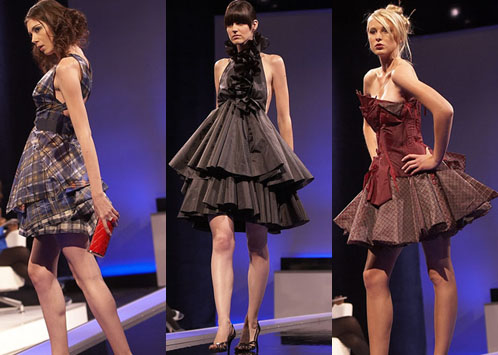 |
In this image, the models are all striking three different poses as they head down the
runway. The purpose of the models is to show off their designers clothing for the week.
The facial expression of all three models varies as well. The first model (going left to
right) has her head and body slightly tilted to left. She has a serious stare but she
leaves us with the question as to where her attention is going. Her glare and mouth
structure gives viewers the feeling of suspense because her facial expression could be
seen as sexual. The model in the middle has a very straightforward look. She is showing
viewers that she is walking down the runway with a purpose and that purpose is to show off
the clothing. Finally, our last model is posing with her shoulders out and head forward in
order to give a better look at her shoulders since the dress is strapless. This is also a
more sexual pose due to her posture and facial expression. Each of the models are
interpellating the audience in order to get their attention to make them see all of them
as desirable. Their job is to catch the eyes of the audience members to make them think
that they either desire to be the model or desire to own the clothes that they're wearing.
They want to persuade the audience members to feel as if they should want everything they
have in order to feel the same type of beauty and power that the models feel when walking
down the runway. Designers have the ability to make the models have a "real" sense of who
they are by applying their styles and putting it on the model. It allows models to go down
the runway and translate a particular look that then gets turn into a real picture like
the ones shown (Handyside). Not only are the models being looked at in a scopophilic way
they can also find the pleasure in being looked at as well (Mulvey, p. 395). If they
didn't enjoy being looked at on the runway they wouldn't be models. |
When the models are shown in a certain way, such as in revealing clothes, it gives the
audience members a chance to express their fantasy and desire to be them. Desire is "the
pleasure gained from fantasizing about lost objects" (Rose, p. 178). "Ordinary people can
watch the show, see people like themselves, and fantasize that that they could gain
celebrity status by being on television" (Reiss and Wiltz, p.374), meaning that viewers
have the ability to want what they see. In A Tale of Inscritption/Fashion Statements, Kim
Swachuk states: "It is, perhaps, this longing for a world of fantasy, this desire for the
return, and the smell and touch of the body which the fashion industry capitalizes on" (p.
60). The fashion industry has the power to make viewers of a fashion television show feel
the need to desire and want what they see. In Project Runway the viewers have the ability
to desire three things: the designer, the fashion or clothing, and the model.
